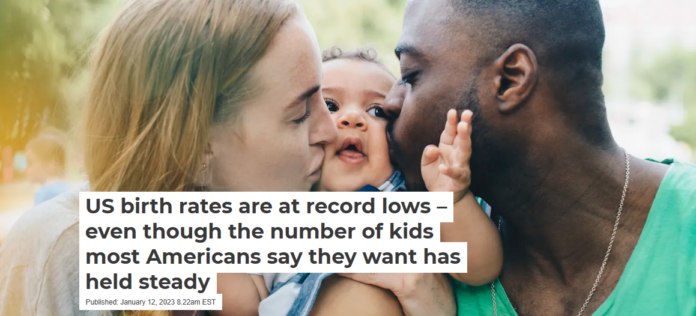
Sarah Hayford, The Ohio State University and Karen Benjamin Guzzo, University of North Carolina at Chapel Hill
Birth rates are falling in the U.S. After the highs of the Baby Boom in the mid-20th century and the lows of the Baby Bust in the 1970s, birth rates were relatively stable for nearly 50 years. But during the Great Recession, from 2007-2009, birth rates declined sharply – and they’ve kept falling. In 2007, average birth rates were right around 2 children per woman. By 2021, levels had dropped more than 20%, close to the lowest level in a century. Why?
Is this decline because, as some suggest, young people aren’t interested in having children? Or are people facing increasing barriers to becoming parents?
We are demographers who study how people make plans for having kids and whether they are able to carry out those intentions.
In a recent study, we analyzed how changes in childbearing goals may have contributed to recent declines in birth rates in the United States. Our analysis found that most young people still plan to become parents but are delaying childbearing.
Digging into the demographic data
We were interested in whether people have changed their plans for childbearing over the past few decades. And we knew from other research that the way people think about having children changes as they get older and their circumstances change. Some people initially think they’ll have children, then gradually change their views over time, perhaps because they don’t meet the right partner or because they work in demanding fields. Others don’t expect to have children at one point but later find themselves desiring to have children or, sometimes, unexpectedly pregnant.
So we needed to analyze both changes over time – comparing young people now to those in the past – and changes across the life course – comparing a group of people at different ages. No single data set contains enough information to make both of those comparisons, so we combined information from multiple surveys.
Since the 1970s, the National Surveys of Family Growth, a federal survey run by the National Centers for Health Statistics, have been asking people about their childbearing goals and behaviors. The survey doesn’t collect data from the same people over time, but it provides a snapshot of the U.S. population about every five years.
Using multiple rounds of the survey, we are able to track what’s happening, on average, among people born around the same time – what demographers call a “cohort” – as they pass through their childbearing years.
For this study, we looked at 13 cohorts of women and 10 cohorts of men born between the 1960s and the 2000s. We followed these cohorts to track whether members intended to have any children and the average number of children they intended, starting at age 15 and going up to the most recent data collected through 2019.
We found remarkable consistency in childbearing goals across cohorts. For example, if we look at teenage girls in the 1980s – the cohort born in 1965-69 – they planned to have 2.2 children on average. Among the same age group in the early 21st century – the cohort born in 1995-1999 – girls intended to have 2.1 children on average. Slightly more young people plan to have no children now than 30 years ago, but still, the vast majority of U.S. young adults plan to have kids: about 88% of teenage girls and 89% of teenage boys.
We also found that as they themselves get older, people plan to have fewer children – but not by much. This pattern was also pretty consistent across cohorts. Among those born in 1975-79, for instance, men and women when they were age 20-24 planned to have an average of 2.3 and 2.5 children, respectively. These averages fell slightly, to 2.1 children for men and 2.2 children for women, by the time respondents were 35-39. Still, overwhelmingly, most Americans plan to have children, and the average intended number of children is right around 2.
So, if childbearing goals haven’t changed much, why are birth rates declining?
What keeps people from their target family size?
Our study can’t directly address why birth rates are going down, but we can propose some explanations based on other research.
In part, this decline is good news. There are fewer unintended births than there were 30 years ago, a decrease linked to increasing use of effective contraceptive methods like IUDs and implants and improved insurance coverage from the Affordable Care Act.
Compared with earlier eras, people today start having their children later. These delays also contribute to declining birth rates: Because people start later, they have less time to meet their childbearing goals before they reach biological or social age limits for having kids. As people wait longer to start having children, they are also more likely to change their minds about parenting.
But why are people getting a later start on having kids? We hypothesize that Americans see parenthood as harder to manage than they might have in the past.
Although the U.S. economy overall recovered after the Great Recession, many young people, in particular, feel uncertain about their ability to achieve some of the things they see as necessary for having children – including a good job, a stable relationship and safe, affordable housing.
At the same time, the costs of raising children – from child care and housing to college education – are rising. And parents may feel more pressure to live up to high-intensive parenting standards and prepare their children for an uncertain world.
And while our data doesn’t cover the last three years, the COVID-19 pandemic may have increased feelings of instability by exposing the lack of support for American parents.
For many parents and would-be parents, the “right time” to have a child, or have another child, may feel increasingly out of reach – no matter their ideal family size.
Sarah Hayford, Professor of Sociology; Director, Institute for Population Research, The Ohio State University and Karen Benjamin Guzzo, Professor of Sociology and Director of the Carolina Population Center, University of North Carolina at Chapel Hill
This article is republished from The Conversation under a Creative Commons license. Read the original article.




















